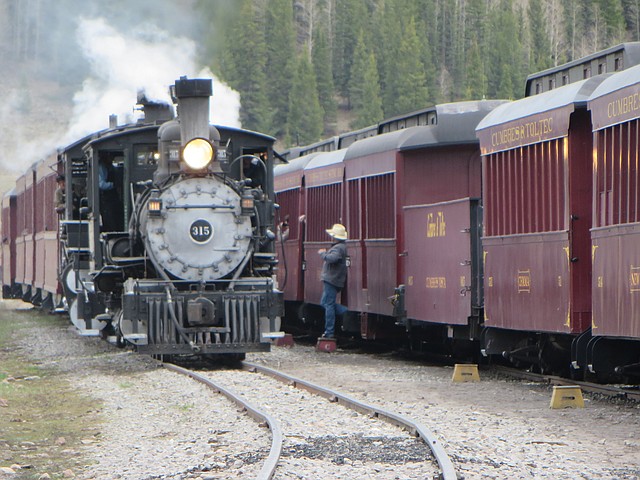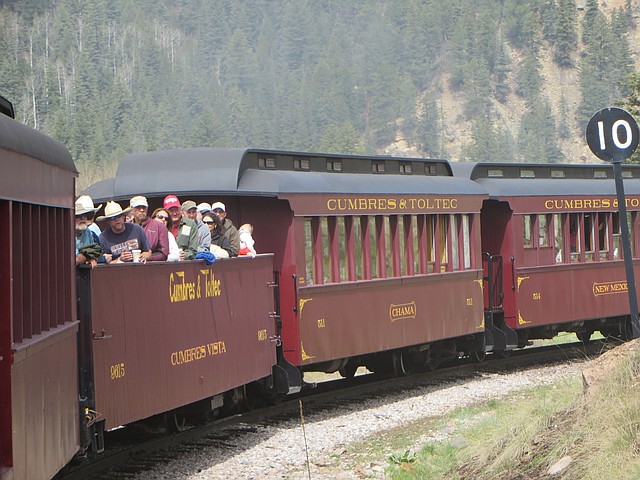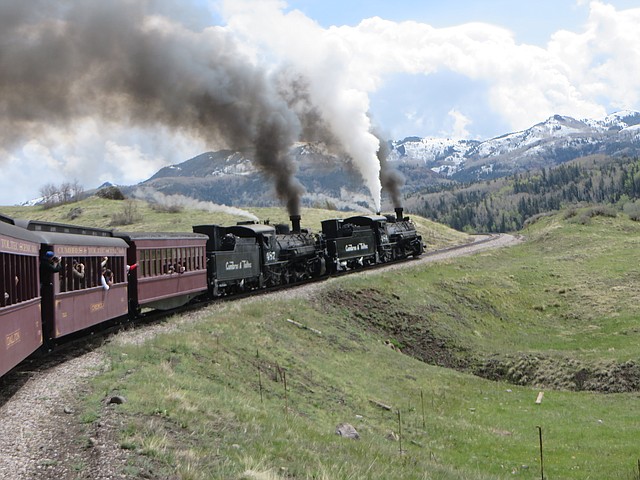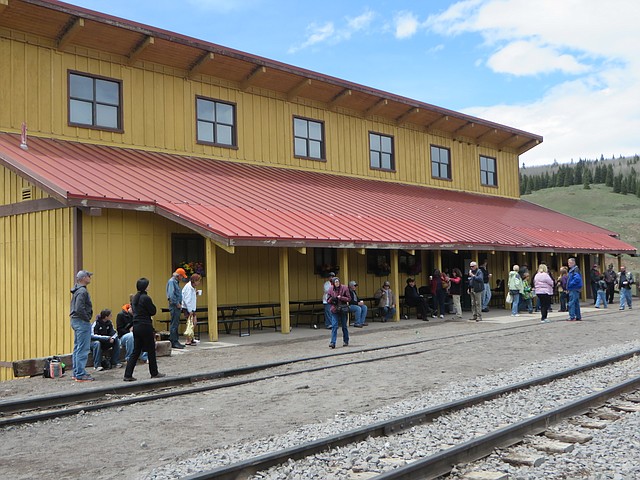Step back into another era on the Cumbres & Toltec Scenic Railroad
June 23, 2014 at 6:00 a.m.
There’s something about rail travel that’s special. It forces you to sit back, relax and just enjoy the passing scenery from the comfort of your window seat. Time slows down and the stresses of day-to-day life start to ebb the further you get from the station. You ease into the rhythm of the train’s motion and realize how much you revel in the simplicity of the situation. This is how travel used to be when rails dominated the landscape.
Today, sadly, many historic trains and their routes are no longer in existence. Only a few remain, saved by state governments and operated by private organizations whose mission it is to preserve and interpret the railroad as a living history museum. Of these, there are just a handful that continue to be run by steam engine, once the power of American industry before the widespread use of gasoline and electric engines. The most authentic of them is the Cumbres & Toltec Scenic Railroad, a proud vestige of the spirit that conquered the West.
Built in 1880, the Cumbres & Toltec was part of the San Juan Extension of the Denver & Rio Grande Railroad with tracks running from Denver through the Rockies to Silverton, Colorado and Santa Fe, New Mexico. Its route through steep passes and deep gorges was an engineering feat for the time. Crews surveyed, graded roadbed and laid track from Antonito, Colorado through breath-taking Toltec Gorge, over 10,015-foot Cumbres Pass and down the four percent grade into Chama, New Mexico. Narrow gauge was chosen so that the railroad could make tighter turns in the mountains and thereby reduce construction costs. The expanded system opened up the region and helped develop its natural resources. It was responsible for hauling ore, timber, cattle and sheep, as well as passengers.
The decline of silver mining in the 1890s, however, ended the railroad’s vital role and over the years, most of the narrow gauge lines in the Rockies were scrapped. By 1967, the Denver & Rio Grande Railroad had filed for abandonment. Fortunately, the most scenic part of its route, its equipment and its buildings were saved by the states of Colorado and New Mexico. Comprising 64 miles of what once was the Denver & Rio Grande Western Railway, the Cumbres & Toltec Scenic Railroad is the finest example of narrow gauge, mountain steam railroading in the country. It is America’s longest and highest narrow gauge railroad and has been designated both a National and State Registered Historic Site and National Civil Engineering Landmark.
Thousands of folks ride this famed train each year between the months of May and October; embarking on the ride of a lifetime as they travel between Colorado and New Mexico, from the Mountains of the San Juans to the Conejos Valley. Trains depart from either Chama in Northern New Mexico or from Antonito on the Colorado side. Passengers can ride the train for the full 64 miles and then hop on a motor coach for the return journey or they can opt to take it to the halfway point, Osier, and then return by train. Both itineraries include an all-you-can-eat cafeteria style lunch in the dining hall at Osier. Families with young kids will want to choose the Cinder Bear Experience, a two-hour ride led by a costumed conductor that includes storytelling, games and sing-alongs. There are additional special trips including weekly sunset dinner rides and various themed excursions such as the Geology Train, which is hosted by famed geologists in the region.
The other decision to make when reserving your trip is style of seating preference. For the ultimate comfort and personal service, you’ll want to be in the Parlor Car. Less cushy, but still roomy with individual seating, is the Tourist Car, and then there’s the budget-friendly Coach Car with bench-style seating. Know that wherever you sit, you’ll be able to walk around to your heart’s content, take up position in the vestibules between cars or head to the open air Gondola Car, where friendly and knowledgeable volunteer docents provide information about the geology and history of the area. These individuals are members of the Friends of the Cumbres & Toltec Scenic Railroad, a group dedicated to preserving and restoring all of the railroad’s historic assets that are not used in the regular tourist train operation, as well as to interpreting the railroad to the public and providing preservation management.
When you leave from the station at Chama as I did, you will soon take note of the train’s gradual climb along a serpentine track into the mountains. First, you’ll see a remnant of the historic Lobato sheep ranch, an area of rolling meadows with a high trestle that spans the rushing Wolf Creek below. Aspen trees line the verdant hills and if you’re lucky, you’ll see deer and elk playing hide and seek in the woods. As the train climbs higher, the view of the entire lush Chama Valley is exposed. The grade continues to get steeper, forcing the formidable locomotive to put out max effort in order to pull the train to Cumbres Pass, the highest mountain pass reached by rail in the U.S. It hugs a sheer rock face as it reaches the summit where you’ll be rewarded with picturesque alpine meadows dotted with wildflowers and spectacular vistas of snow-dusted mountains, creating numerous Kodak moments. Early in the season, there’s often some snow still on the ground, as fierce storms are known to leave snow drifts twenty feet or more in the harsh winters. Take note of the historic section house, one of several original buildings that remain along the route. This structure contained dwelling areas for the section foreman and his family along with a kitchen and dining room for the entire section crew.
From Cumbres, the train descends around Windy Point, one of the most famous places in American railroading. Here the rails are laid on a rock shelf carved out of the face of the cliff. Soon, you’ll come to Tanglefoot Curve, a loop so tight that it almost seems the locomotive will come face-to-face with the caboose. At this location, railroad builders had to lay track in wide loops to gain 39 feet in elevation. Eastbound train crews would jump off the slow moving trains on the upper track, walk down to the lower track to inspect the trains for “hot boxes” (burned out bearings) and then get back on the caboose. Story has it that many years ago, a trainman tangled his foot in a briar and slid down the bank almost into the path of his own train – hence the name “Tanglefoot Curve.”
Before pulling into Osier, Colorado, the train crosses 137-foot high Cascade Creek Trestle, the highest bridge on the line. Upon arrival in Osier, passengers disembark for lunch. Once a toll station on the road from Conejos to Chama, this rustic townsite was home to a small community with a store, rooming house for travelers, saloon and restaurant, section house for railroad employees’ families, depot, coal loading dock, covered turntable and cattle pens. Today, a number of these buildings are still in existence, though some like the section house and station have been renovated and restored. The reddish-brown paint color on a few of the structures replicates the original color of all railroad buildings during the 1881-1915 era of the railroad. Of particular mention is the water tank, which is similar to others that can be seen along the line. Water tanks are necessary due to the fact that a locomotive’s tender cannot hold sufficient water to provide steam power for a whole trip. In the early years of the railroad, when locomotives were much smaller, watering facilities had to be positioned every seven to ten miles.
After lunch, those passengers riding the entire 64 miles will reboard the same train they came on, while those riding only half the distance will change trains to return to their point of departure. For the latter group, though the route may be the same, the scenery appears like new due to the different perspective and time of day. It’s an equally spectacular ride as you take in the pristine grandeur of our country’s Wild West while recalling a bygone era.
The Cumbres & Toltec Scenic Railroad operates from May 24th through October 19th during the 2014 season. For schedule and ticket information, call 888-286-2737 or visit www.cumbrestoltec.com
Deborah Stone is a travel and lifestyle writer, who explores the globe in search of unique destinations and experiences to share with her readers. She’s an avid adventurer who welcomes new opportunities to increase awareness and enthusiasm for travel and cross-cultural connections. Her stories appear in a number of publications as well as on various travel websites. Additionally, she can be frequently be heard dishing travel with the hosts of the NPR-affiliated and AARP produced talk radio show, “2 Boomer Babes.” Deborah is a longtime Seattle area resident, who currently resides in Santa Fe, New Mexico.










